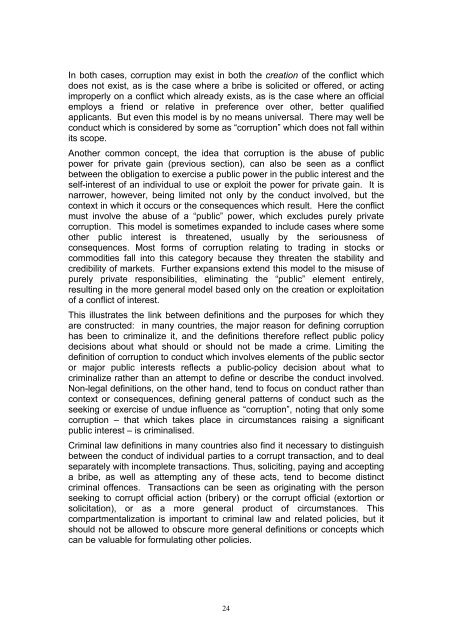UN Guide for Anti-Corruption Policies - United Nations Office on ...
UN Guide for Anti-Corruption Policies - United Nations Office on ...
UN Guide for Anti-Corruption Policies - United Nations Office on ...
You also want an ePaper? Increase the reach of your titles
YUMPU automatically turns print PDFs into web optimized ePapers that Google loves.
In both cases, corrupti<strong>on</strong> may exist in both the creati<strong>on</strong> of the c<strong>on</strong>flict which<br />
does not exist, as is the case where a bribe is solicited or offered, or acting<br />
improperly <strong>on</strong> a c<strong>on</strong>flict which already exists, as is the case where an official<br />
employs a friend or relative in preference over other, better qualified<br />
applicants. But even this model is by no means universal. There may well be<br />
c<strong>on</strong>duct which is c<strong>on</strong>sidered by some as “corrupti<strong>on</strong>” which does not fall within<br />
its scope.<br />
Another comm<strong>on</strong> c<strong>on</strong>cept, the idea that corrupti<strong>on</strong> is the abuse of public<br />
power <str<strong>on</strong>g>for</str<strong>on</strong>g> private gain (previous secti<strong>on</strong>), can also be seen as a c<strong>on</strong>flict<br />
between the obligati<strong>on</strong> to exercise a public power in the public interest and the<br />
self-interest of an individual to use or exploit the power <str<strong>on</strong>g>for</str<strong>on</strong>g> private gain. It is<br />
narrower, however, being limited not <strong>on</strong>ly by the c<strong>on</strong>duct involved, but the<br />
c<strong>on</strong>text in which it occurs or the c<strong>on</strong>sequences which result. Here the c<strong>on</strong>flict<br />
must involve the abuse of a “public” power, which excludes purely private<br />
corrupti<strong>on</strong>. This model is sometimes expanded to include cases where some<br />
other public interest is threatened, usually by the seriousness of<br />
c<strong>on</strong>sequences. Most <str<strong>on</strong>g>for</str<strong>on</strong>g>ms of corrupti<strong>on</strong> relating to trading in stocks or<br />
commodities fall into this category because they threaten the stability and<br />
credibility of markets. Further expansi<strong>on</strong>s extend this model to the misuse of<br />
purely private resp<strong>on</strong>sibilities, eliminating the “public” element entirely,<br />
resulting in the more general model based <strong>on</strong>ly <strong>on</strong> the creati<strong>on</strong> or exploitati<strong>on</strong><br />
of a c<strong>on</strong>flict of interest.<br />
This illustrates the link between definiti<strong>on</strong>s and the purposes <str<strong>on</strong>g>for</str<strong>on</strong>g> which they<br />
are c<strong>on</strong>structed: in many countries, the major reas<strong>on</strong> <str<strong>on</strong>g>for</str<strong>on</strong>g> defining corrupti<strong>on</strong><br />
has been to criminalize it, and the definiti<strong>on</strong>s there<str<strong>on</strong>g>for</str<strong>on</strong>g>e reflect public policy<br />
decisi<strong>on</strong>s about what should or should not be made a crime. Limiting the<br />
definiti<strong>on</strong> of corrupti<strong>on</strong> to c<strong>on</strong>duct which involves elements of the public sector<br />
or major public interests reflects a public-policy decisi<strong>on</strong> about what to<br />
criminalize rather than an attempt to define or describe the c<strong>on</strong>duct involved.<br />
N<strong>on</strong>-legal definiti<strong>on</strong>s, <strong>on</strong> the other hand, tend to focus <strong>on</strong> c<strong>on</strong>duct rather than<br />
c<strong>on</strong>text or c<strong>on</strong>sequences, defining general patterns of c<strong>on</strong>duct such as the<br />
seeking or exercise of undue influence as “corrupti<strong>on</strong>”, noting that <strong>on</strong>ly some<br />
corrupti<strong>on</strong> – that which takes place in circumstances raising a significant<br />
public interest – is criminalised.<br />
Criminal law definiti<strong>on</strong>s in many countries also find it necessary to distinguish<br />
between the c<strong>on</strong>duct of individual parties to a corrupt transacti<strong>on</strong>, and to deal<br />
separately with incomplete transacti<strong>on</strong>s. Thus, soliciting, paying and accepting<br />
a bribe, as well as attempting any of these acts, tend to become distinct<br />
criminal offences. Transacti<strong>on</strong>s can be seen as originating with the pers<strong>on</strong><br />
seeking to corrupt official acti<strong>on</strong> (bribery) or the corrupt official (extorti<strong>on</strong> or<br />
solicitati<strong>on</strong>), or as a more general product of circumstances. This<br />
compartmentalizati<strong>on</strong> is important to criminal law and related policies, but it<br />
should not be allowed to obscure more general definiti<strong>on</strong>s or c<strong>on</strong>cepts which<br />
can be valuable <str<strong>on</strong>g>for</str<strong>on</strong>g> <str<strong>on</strong>g>for</str<strong>on</strong>g>mulating other policies.<br />
24

















